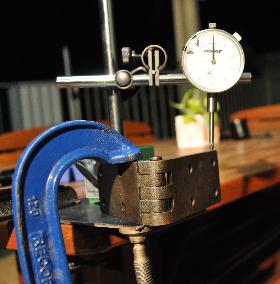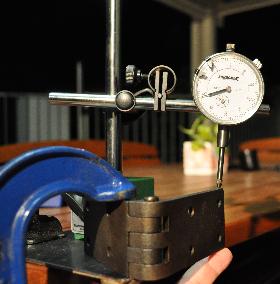The MGA With An Attitude
DOOR HINGE, Loose Hinge Pin -- FT-073
Moss Motors, USA part no: 470-960
Moss Motors, UK part no: AFH5832
| Replacement for BMC AFH1404 Hinge, door R/H | (2) - Fin (c)56068 |
| Replacement for BMC AFH2805 Hinge, door R/H | (2) - Fin (c)56068 |
| Replacement for BMC AFH5832 Hinge, door | (4) - Com (c)56069 |
Note: These parts must be installed in mated pairs
(same part number) to assure equal opening angles for one door.
 This problem has been reported repeatedly for some time, and some parts have been returned to the vendor, but these hinges are still being sold with loose hinge pins (perhaps not as bad as previously).
This problem has been reported repeatedly for some time, and some parts have been returned to the vendor, but these hinges are still being sold with loose hinge pins (perhaps not as bad as previously).
On October 9, 2014, R J Goebel in Queensland, Australia, wrote:
"Found hinges supplied by NOS locators, sent an email asking about quality issues, no response.
Looked up MOSS, sent an email asking about quality issues. Received a response and was assured that current stock was good after some quality issues arose earlier this year. The hinges arrived two days ago and have more free play than those on the car. I sent an email to MOSS about the issue, however as of now they have not responded".
On October 11, 2014, R J Goebel wrote:
"To ensure I am not being unreasonable I measured the movement of the hinge when fully extended. movement is just under 0.070 at the end of the hinge, which would translate to considerably more at the latch edge of the door if the hinge(s) were fitted. Attached are two pictures showing my method of measuring the looseness. So could you confirm or otherwise that 0.070 is excessive".


The hinges do not actually move in that manner in service. They will attached to the door and car body so they move as an integrated assembly. Not having this part in hand, I can make some estimates of hinge pin to bore hole clearance, and calculate the expected motion of the door.
Assume each leaf of the hinge is 2-1/2" tall and 4-1/2" long. Each finger will be 1/2" tall, and the distance between top and bottom joint slot will be 1-1/2". This gives a mechanical ratio of 4.5/1.5 or 3:1 between the hinge pin horizontal motion and the vertical motion at end of leaf. So total motion at the hinge pin could be 0.070/3 = 0.0233". Half of this motion will be at the top joint, and half at the bottom joint, so internal clearance around the hinge in might be 0.0233/2 = 0.0116". This also assumes that the pin is tight (will not move) in the 3-finger leaf, and all of the motion is in the 2-finger leaf (worst case). If any of the motion occurs in the 3-finger leaf, then the internal clearance would be slightly smaller (but this does not affect the total measured wiggle).
Without measuring my car door, I will estimate vertical distance between hinges (center to center) to be 12", and door horizontal length to be 24" from hinge pin to latch striker. Since both hinges have internal clearance, each can move in opposite direction, so total relative horizontal motion between the pins would be 0.0116x2 = 0.0232". Door length being twice the hinge spacing, vertical motion at rear end of the door would be 0.0232x2 = 0.0464". That is only 3/64-inch vertically, and it will be damped by gravity so the door will not normally jiggle up and down (unless the body flexes while driving).
I don't know if this would be any problem in service. Reducing pin clearance from 0.0116" to 0.003" could reduce the jiggle at back end of door from 0.0464" to 0.012". That would be a reduction of 1/32-inch of vertical wiggle at the back end of the door. I suppose this is not a functional problem when the hinges are new. As the hinges wear this motion will increase, and it will always be 1/32-inch greater when starting with the looser pin. It would be nice if the pins had less clearance when new, but I would not call this a Faulty Part due to this issue. I would install the parts for trial before jumping to any rash conclusion about real world function of the hinges.
|